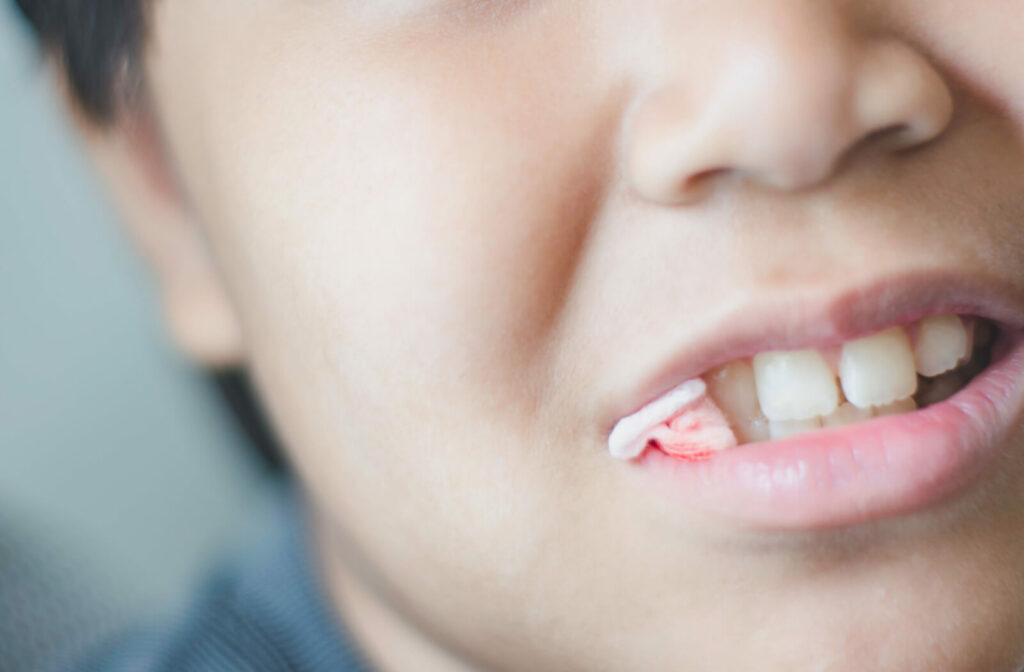Dental procedures can be uncomfortable experiences for some people, but they’re essential for your dental health. Something like a tooth extraction can prevent infection from spreading and remove decaying teeth. After undergoing a dental procedure such as this, your dentist may advise you to use gauze to control bleeding and promote healing.
Gauze is a soft and absorbent material commonly used in dentistry to address bleeding and encourage clotting after procedures like extractions, wisdom tooth surgery, root canals, and other oral surgeries. You should keep an eye on the amount you’re bleeding after surgery to know when to stop using gauze after tooth extraction.
When Should I Stop Using Gauze After Tooth Extraction?
Typically, we’ll advise patients to keep the gauze in place for around 15-30 minutes after the procedure. During this time, it’s important to bite down firmly on the gauze to encourage clotting. Once the bleeding has subsided, we’ll usually remove the gauze and instruct you to continue the healing process at home. However, in some cases, we may advise keeping the gauze in place for up to 24 hours.
If you need help knowing when to stop using gauze after tooth extraction, there are a few signs to pay attention to.
You should replace your gauze every 15-30 minutes, checking it for blood when you do. If the area still seems to be bleeding, bite down on fresh gauze or a wet black tea bag for 15-30 minutes. Pressure will help to slow/stop the bleeding. The first sign it’s time to stop using gauze is when the bleeding has stopped and the gauze you’re changing out remains clean and dry. This means that a blood clot is forming, and the initial healing process has begun. Once 24 hours have passed since your surgery, rinse your mouth gently with warm salt water several times a day to help clean the extraction site and promote healing.
Avoid spitting or rinsing vigorously, as this can dislodge the blood clot and cause bleeding to resume. In addition, you should avoid smoking, drinking through a straw, and eating hard, crunchy, or sticky foods, as these can also dislodge the blood clot and hinder your healing.

When Should I Keep Gauze on After Tooth Extraction?
While knowing when to remove your gauze is essential, since using gauze for too long might make you bleed for longer, you should also look out for signs indicating you should keep the gauze on.
Check your gauze pad 1 hour after surgery. If the spot is still bleeding, replace the gauze and keep firm pressure by biting down. Repeat this process until the bleeding stops. If you’re still bleeding a lot and it’s been 4 hours since your surgery, call your dentist.
Another reason you might need to keep the gauze on is if you experience a dry socket. A dry socket occurs when the blood clot at the extraction site dislodges or dissolves, exposing the underlying bone and nerves. This condition can be a painful and uncomfortable experience and can lead to infection if left untreated.
If you experience severe pain, bad breath, or a foul taste in your mouth, you may have a dry socket and should contact your dentist immediately. In this case, we may advise you to keep the gauze in place for longer or prescribe medication to help manage the pain and prevent infection.
Why Is Gauze Helpful?
A gauze pad is crucial in managing bleeding and promoting healing after dental procedures. Biting down on gauze applies pressure to the extraction site, which helps the blood clot and prevents bleeding.
In addition, gauze is absorbent, which means that it can help absorb excess blood and saliva from the extraction site, reducing the risk of infection. However, since blood and saliva can mix, it can look like you’re bleeding more than you are, even with gauze in place.
Why Shouldn’t I Use Gauze Indefinitely?
While gauze helps with bleeding and healing, you shouldn’t use it indefinitely. Using gauze for an extended period can prevent the formation of a blood clot and delay the healing process, leading to complications like dry socket, infection, and prolonged pain.
Instead of using gauze indefinitely, you can switch to other remedies to aid healing. For instance, you can rinse your mouth with warm salt water 4–5 times a day to help keep the extraction site clean and prevent infection. You can also apply a cold compress to your cheek to help reduce swelling and discomfort. On the second day, you can switch to a warm compress.
Try to relax for 2 days after your surgery, as an elevated heart rate may increase bleeding at the operation site. It’s a good time to skip the gym for the next 48—72 hours. In addition, stick to a soft diet, such as yogurt, applesauce, and pasta, for the first few days after the procedure to avoid irritating the extraction site.
Post-Gauze Care
After the first night following a tooth extraction, and the bleeding has fully stopped and a blood clot formed, it is critical to follow your dentist or oral surgeon’s instructions for post-gauze care. Make sure to also avoid any activities that could potentially dislodge the blood clot, such as using a straw, smoking, and vigorous physical activity. It’s also important to maintain good oral hygiene to prevent the risk of complications. Your dentist or oral surgeon will also provide instructions for managing swelling, as well as any pain-relief you may need.
Local Answers to Your Questions
Taking care of yourself after tooth extraction requires attention and care, but it shouldn’t be stressful. Hometown Dental’s knowledgeable team will send you home with advice to help make your recovery smooth and comfortable.If you have any questions about tooth extractions, either about the surgery or the aftercare, don’t hesitate to contact us.





